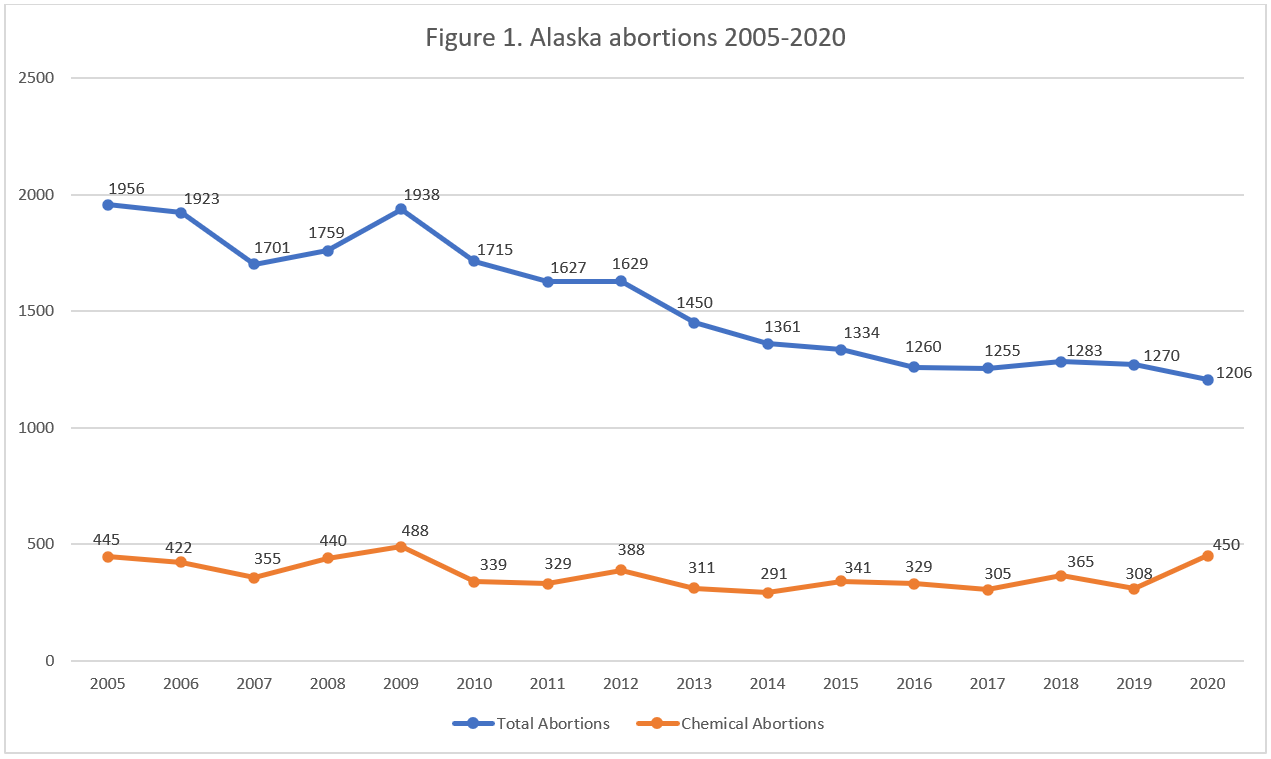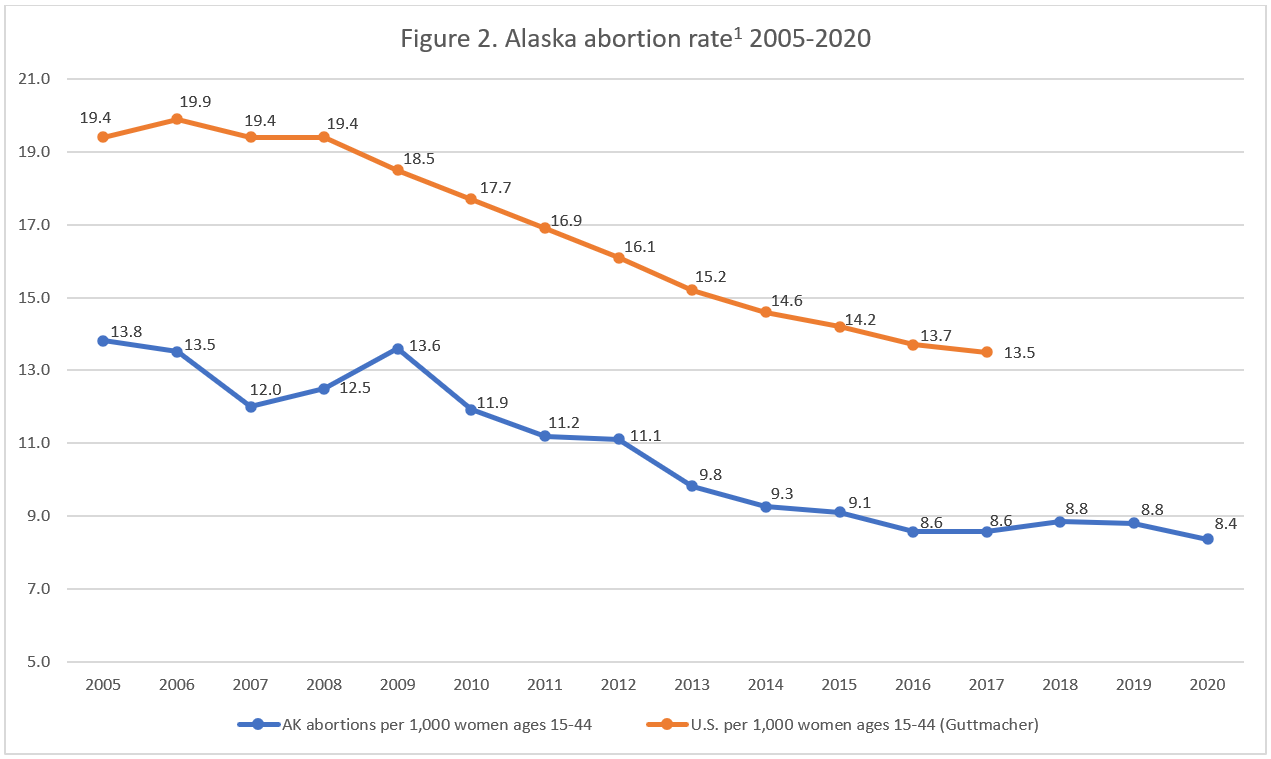Abortion Reporting: Alaska (2020)
Alaska was one of the first states to release an abortion report for 2020. Abortions declined from the previous year.
Changes in Alaska Abortions, 2019-2020

The report does not include information on Planned Parenthood’s Alaska abortion market share.
Abortion Totals and Trends
There were 1,206 abortions reported in Alaska in 2020, down five percent from the previous year and the lowest annual total since Alaska began publishing abortion statistics in 2003 (Fig. 1). At the same time, chemical abortions jumped by 46 percent, an increase of 142 chemical abortions from the previous year. The Charlotte Lozier Institute (CLI) estimates that Alaska’s 2020 abortion rate was 8.4 abortions per 1,000 women ages 15 to 44, a decrease of five percent from 2019 and lower than the national rate (Fig. 2). As of September 2021, 16 states had released 2020 abortion statistics, with 11 reporting increases from 2019.
State Report Summary
Over 99 percent of the abortions reported in Alaska in 2020 were performed on state residents. Just eight abortions were performed on women from other states, while three abortions were on women of unknown residency.
Eleven percent of the abortions were performed on girls under the age of 20. Thirty percent were performed on women ages 20 to 24, and 26 percent were on women ages 25 to 29. A fifth of the abortions were on women in their early thirties, while 10 percent were performed on women in their later thirties, and three percent were obtained by women aged 40 or older.
Just under half the abortions (49 percent) were performed on white women. Twenty percent were on American Indian or Alaska Native women, and nine percent were on Asian or Pacific Islander women. Seven percent of the abortions were performed on black women, and 11 percent were obtained by women of other or multiple races. Race was not reported for three percent of the women getting abortions in Alaska. Eighty-nine percent of the abortions were performed on non-Hispanic women, five percent were on Hispanic women, and seven percent were on women of unknown ethnicity.
Nine percent of the abortions were performed on women with less than 12 years of education. Forty-nine percent of the abortions were on women with 12 years of education, and 36 percent were on women with 13 or more years. Level of education was not reported for six percent of the abortions.
Twenty-one percent of the abortions were performed on married women, a higher percentage than in many other states. Seventy-four percent of the abortions were on unmarried women, and five percent were on women of unknown marital status.
Forty-six percent of the abortions were performed on women with no previous live births. Twenty percent had one prior live birth, and 34 percent had two or more previous births. Sixty-five percent had no prior abortions, while 23 percent had one previous abortion and 12 percent had more than one.
Over half the abortions (51 percent) were performed using suction curettage. Thirty-seven percent were chemical abortions induced with mifepristone, and 11 percent were dilation and evacuation procedures. There was one hysterotomy abortion, and one abortion performed using another unspecified procedure.
Four percent of Alaska abortions were performed between one and four weeks of gestation, and 64 percent were performed between five and eight weeks. Twenty-three percent of the abortions were reported between nine and 12 weeks of gestation. Ten percent of the abortions were performed between 13 and 16 weeks of gestation, and not quite one percent were reported between 17 and 20 weeks; no abortions were reported at 21 weeks of gestation or later though state law does not contain a gestational age limit on abortion.
In 2020, 38 percent of Alaska abortions were covered by state tax dollars. Six percent were funded by insurance, and 42 percent were self-pay. Fourteen percent were funded by some other means.
Fourteen percent of the women undergoing abortions received a copy of Alaska’s informed consent materials. According to the report, 0.2 percent of the abortions were performed due to congenital anomalies, but the report does not share what these conditions were.
For the first time, Alaska’s 2020 abortion report contained a note that “The state reported data may include terminations that were medically necessary to save the mother’s life, or were not elective such as ectopic or molar pregnancies, or where medication was provided to manage a miscarriage. However, reasons for a terminated pregnancy are not reported to the state.” Alaska’s definition of “induced termination of pregnancy” in the Vital Statistics Act does not include ectopic pregnancies or miscarriages, so CLI asked the Alaska Department of Health and Social Services for clarification. The department responded that they cannot tell whether a reported abortion involved an ectopic or molar pregnancy, but that miscarriages are different from abortions and are not included in abortion reporting. The department did not respond to a follow-up question.
Chemical Abortion & Aid Access
Alaska reported a jump in chemical abortions in 2020. During the pandemic, some women may have chosen to conduct their chemical abortion appointments via telemedicine. In the early part of 2020, that would have involved picking up their pills from an abortion center or obtaining them from unlicensed websites. That changed in July, when a federal judge suspended safety regulations from the Food and Drug Administration (FDA) that require mifepristone to be dispensed in person.
A major online abortion pill distributor in Alaska is Aid Access. Before the pandemic, Aid Access was in violation of FDA safety guidelines; doctors in Europe would write abortion pill prescriptions for American women, which would then be filled by a pharmacy in India. Aid Access’ Alaska shipments were low, and the organization expected fewer than 10 contacts from Alaska women requesting abortion pills in March and April of 2020. In April, Aid Access suspended its activities, but resumed operations in mid-2020. With the FDA in-person requirement suspended, Aid Access began mailing abortion pills to certain states via United States-based physicians, while its European physicians continued to prescribe mifepristone in other states. By late 2020, the U.S. branch of Aid Access had begun operating in Alaska. In April 2021, the FDA officially suspended the in-person requirement for the duration of the pandemic.
Alaska’s abortion reporting requirements only apply to medical professionals and healthcare facilities operating within the state of Alaska. The Department of Health and Social Services confirmed for CLI that physicians and organizations mailing abortion pills from outside the state, including Aid Access, are not required to report abortions. Aid Access does not indicate whether any of its doctors are located in Alaska (and would consequently be required to report abortion pills they prescribe to Alaska women), and Aid Access has not shared the number of pills it has distributed in Alaska. Consequently, chemical abortions in Alaska may be underreported, and this underreporting may worsen if Aid Access or other online distributors increase their volume.
State Ranking
In a 2016 CLI paper evaluating abortion reporting across the United States, Alaska’s reporting tied for 21st best. Alaska makes its reports available in a timely manner and is typically one of the first states to release statistics each year. However, the Frontier State could work to improve its reporting further. Chemical abortions have a higher complication rate than surgical abortions, and as chemical abortions increase in Alaska, the state could measure the impact by collecting and reporting abortion complication data. Alaska could also consider requiring reporting from any entity mailing abortion drugs into the state.


- Rates were calculated by CLI using the following formula: (total number of abortions performed in Alaska ÷ number of resident women ages 15-44) x 1,000. Rates may differ slightly from previous CLI articles due to revised population estimates. Population estimates were obtained from the CDC WONDER database.
























